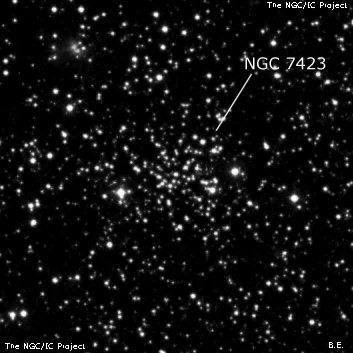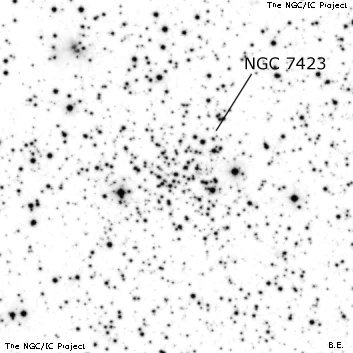NGC/IC Project Restoration Effort
(This is a very very beta version)
NGC7423


Basic Information
Location and Magnitude
Right Ascension: 22:55:6.5
Declination: +57:5:41
Constellation: CEP
Visual Magnitude:
Historic Information
Discoverer: Herschel W.
Year of discovery: 1788
Discovery aperture: 18.7
Observational
Summary description: vF, pL, iF, er
Sub-type: II3m
Corwin's Notes
=====
NGC 7423 is a nice, compressed cluster at the NGC position. It sits between
two brighter stars, and would probably be an interesting, if faint, object at
the eyepiece.
JH was not sure in his 1833 catalogue if this was his father's III 745 or not.
When he compiled the GC, however, he adopted his own position and his father's
description. This is actually the best combination as both are correct. WH's
position, however, is a minute of time east of the JH's position. Dreyer
noticed this when he published all of WH's papers in 1912, and wrote a short
note about it. In that note, Dreyer also mentions "In the sweep a star 6 mag
= +56 2923 is 3m 41s f, 10' s." Doing the math from WH's reference star
(Delta Cephei) for III 745, the BD star ends up close to its true position --
but III 745 is stubbornly 1 minute of time off.
Curiously, RNGC calls the cluster non-existent though it is clear on the POSS,
and is included in the cluster catalogues as Berkeley 57 (that identity was
apparently first noticed by Alister Ling in 1985). SIMBAD mistakenly equates
the cluster with a faint planetary (an infrared source) a few arcmin to the
northeast.
Steve's Notes
=====
NGC 7423
18" (9/24/05): at 225x, this cluster appears as a small, rich, glowing spot 2' in diameter, peppered with roughly a dozen mag 14-15 stars, several of which are just on the edge of visibility. Set within a rich low power Milky Way star field, although noticed immediately at 115x. A wide pair of mag 11 stars is just off the SW side. At 435x, the faint resolved stars are easier to view, although the background glow fades. Planetary nebula M 1-80 is just 10' ENE. M 1-80 was easily picked up by blinking at 160x with an OIII filter, although appears slightly soft at this power unfiltered. Excellent view at 538x unfiltered as a slightly irregular small disc, ~4" diameter. Situated ~40" W of a mag 11 star. A very close pair of mag 14.5-15 stars follows the mag 11 star and a brighter double is close north.



